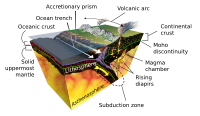
Photo from wikipedia
Abstract Active source near-vertical reflection (NVR) data from the interdisciplinary project TIPTEQ were used to image and identify structural and petrophysical properties within the Chilean subduction zone at 38.25°S, where… Click to show full abstract
Abstract Active source near-vertical reflection (NVR) data from the interdisciplinary project TIPTEQ were used to image and identify structural and petrophysical properties within the Chilean subduction zone at 38.25°S, where in 1960 the largest earthquake ever recorded (Mw 9.5) occurred. Reflection seismic images of the subduction zone were obtained using the post-stack depth migration technique to process the three components of the NVR data, allowing to present P- and S-stacked time sections and depth-migrated seismic reflection images. Next, the reflectivity method allowed to model traveltimes and amplitude ratios of pairs of reflections for two 1D profiles along the studied transect. The 1D seismic velocities that produced the synthetic seismograms with amplitudes and traveltimes that fit the observed ones were used to infer the rock composition of the different layers in each 1D profile. Finally, an image of the subduction zone is given. The Chilean subduction zone at 38.25°S underlies a continental crust with highly reflective horizontal, as well as dipping events. Among them, the Lanalhue Fault Zone (LFZ), interpreted to be east-dipping, is imaged to very shallow depths for the first time. In terms of seismic velocities, the inferred composition of the continental crust is in agreement with field geology observations at the surface along the profile. Furthermore, no measurable amounts of fluids above the plate interface in the continental crust in this part of the Chilean subduction zone are necessary to explain the results. A large-scale anisotropy in the continental crust and upper mantle is qualitatively proposed. However, quantitative studies on this topic in the continental crust of the Chilean subduction zone at 38.25°S do not exist to date.
Journal Title: Tectonophysics
Year Published: 2018
Link to full text (if available)
Share on Social Media: Sign Up to like & get
recommendations!